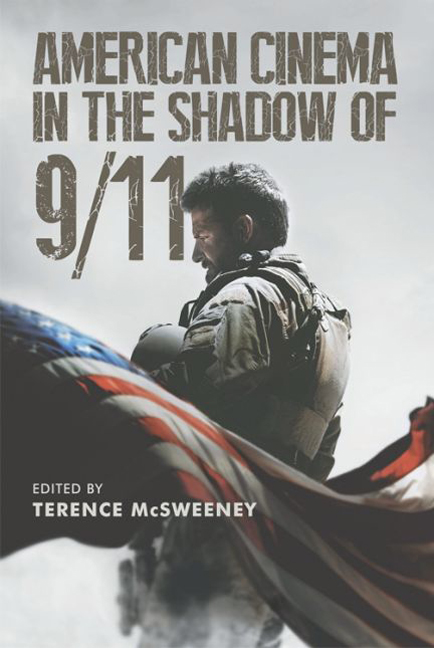Book contents
- Frontmatter
- Contents
- List of Figures
- Acknowledgements
- Foreword
- Introduction: American Cinema in the Shadow of 9/11
- Part I Dramatisations of the ‘War on Terror’
- Part II Influences of the ‘War on Terror’
- Part III Allegories of the ‘War on Terror’
- 11 ‘Daddy, I'm ScareD. Can We Go Home?’ Fear and Allegory in Frank Darabont's the Mist (2007)
- 12 The Terrible, Horrible Desire to Know: Post-9/11 Horror Remakes, Reboots, Sequels and Prequels
- 13 Post-9/11 Power and Responsibility in the Marvel Cinematic Universe
- 14 Nowhere Left to Zone in Children of Men (2006)
- 15 Traumatise, Repeat, Finish: Military Science Fiction (long) After 9/11 and Doug Liman's Edge of Tomorrow (2014)
- Selected Filmography
- Notes on the Contributors
- Index
15 - Traumatise, Repeat, Finish: Military Science Fiction (long) After 9/11 and Doug Liman's Edge of Tomorrow (2014)
from Part III - Allegories of the ‘War on Terror’
Published online by Cambridge University Press: 10 May 2017
- Frontmatter
- Contents
- List of Figures
- Acknowledgements
- Foreword
- Introduction: American Cinema in the Shadow of 9/11
- Part I Dramatisations of the ‘War on Terror’
- Part II Influences of the ‘War on Terror’
- Part III Allegories of the ‘War on Terror’
- 11 ‘Daddy, I'm ScareD. Can We Go Home?’ Fear and Allegory in Frank Darabont's the Mist (2007)
- 12 The Terrible, Horrible Desire to Know: Post-9/11 Horror Remakes, Reboots, Sequels and Prequels
- 13 Post-9/11 Power and Responsibility in the Marvel Cinematic Universe
- 14 Nowhere Left to Zone in Children of Men (2006)
- 15 Traumatise, Repeat, Finish: Military Science Fiction (long) After 9/11 and Doug Liman's Edge of Tomorrow (2014)
- Selected Filmography
- Notes on the Contributors
- Index
Summary
ARE WE STILL POST-9/11? THE COLD WAR PARADIGM
While literal representations of the events of 11 September 2001 have rarely garnered commercial rewards to match critical accolades – United (2006) comes to mind – horror and science fiction films have thrived in the aftermath of the attacks. In fact, the events of 9/11 have initiated a cultural cycle that retains its hold on the popular imagination to the present day. From the safe distance of the two genres’ more hyperbolic signature tropes – among them most notably the zombie apocalypse and the alien invasion – horror and science fiction cinema have often come to rely on 9/11 as a topical reference point. The iconography of 9/11 would grow into a reference system equivalent in evocative intensity and cultural universality only to the Cold War and its preoccupation with nuclear anxieties. A few well-chosen images, a clichéd reference to a certain technology – radioactivity in the case of the Cold War, international terrorism in the case of the post-9/11 period – would be sufficient to subsume diverse political, social and cultural phenomena under a single historical paradigm.
The example of the Cold War as a point of reference is not arbitrarily chosen. Not long after the attacks on the World Trade Center, post-9/11 America seemed to acquire quite a few traits uncannily reminiscent of the 1950s. From the sudden spike in xenophobia, as a backdrop to both domestic and foreign policy, to the ‘us versus them’ attitude by which the Bush administration rhetorically divided friends and enemies, the paranoia accompanying the enforcement of political and ideological conformity, and the demonisation of an enemy that was everywhere and nowhere at the same time – the early years of the Cold War seemed like a fair approximation of what it felt like to live in the aftermath of 9/11. Depending on one's political position, the historical analogy with the 1950s communicated either the valour of newly rediscovered American greatness, the continuation of the ‘American Century’ in the hands of the ‘Project for the New American Century’, or the more dystopian version of a 1950s America in the grip of hysterical McCarthyite witch-hunts and apocalyptic end-times visions.
The analogy between the Cold War and the post-9/11 period might have been politically useful, but it would quickly prove itself to be skewed in two crucial respects.
- Type
- Chapter
- Information
- American Cinema in the Shadow of 9/11 , pp. 307 - 326Publisher: Edinburgh University PressPrint publication year: 2017



